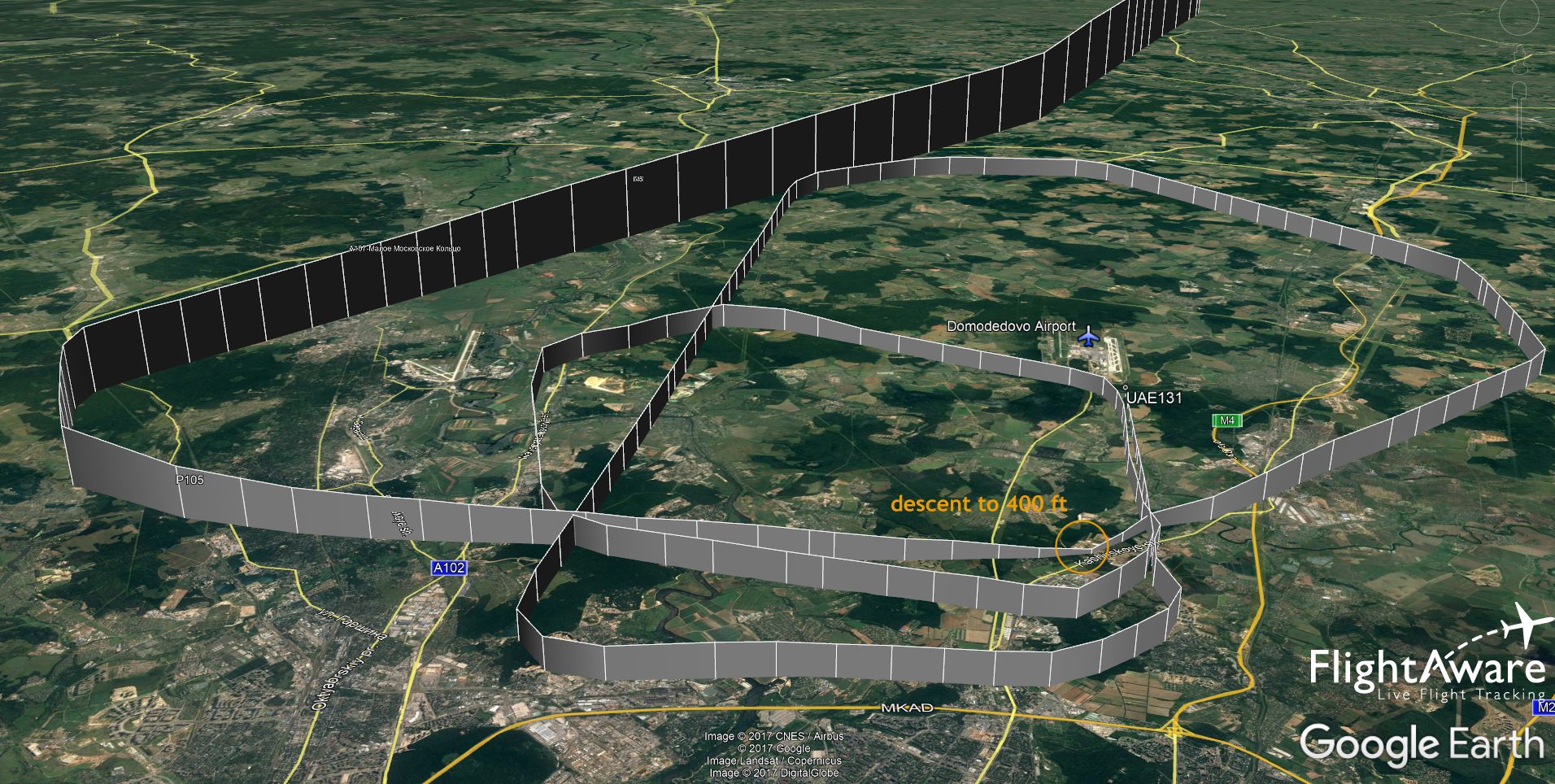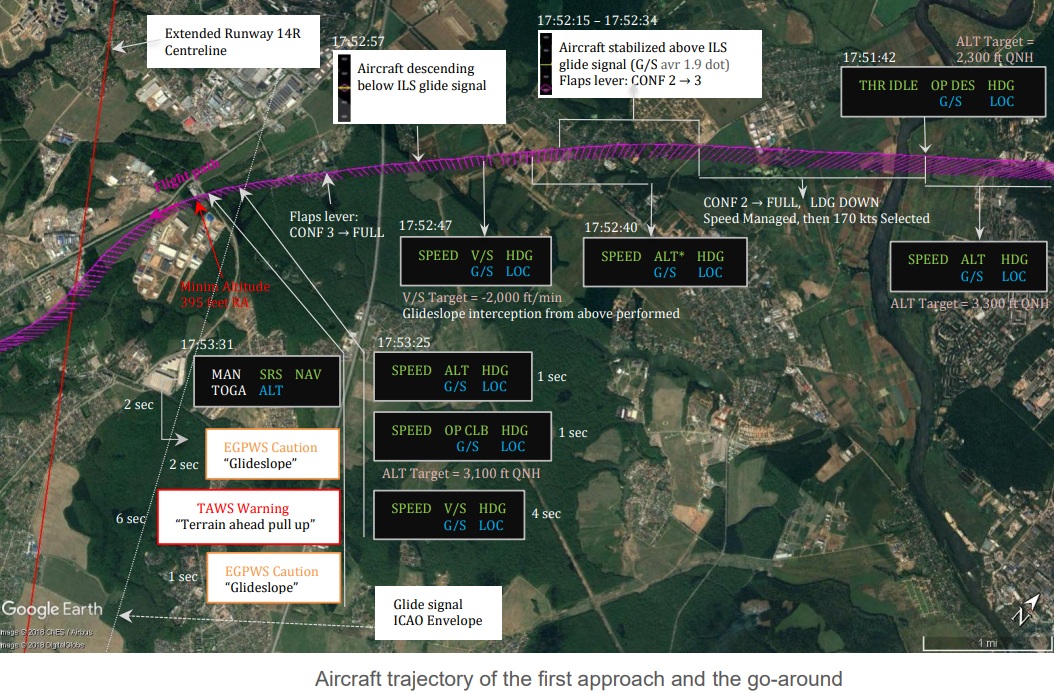
ASN Wikibase Occurrence # 199901
This information is added by users of ASN. Neither ASN nor the Flight Safety Foundation are responsible for the completeness or correctness of this information.
If you feel this information is incomplete or incorrect, you can submit corrected information.
| Date: | Sunday 10 September 2017 |
| Time: | c. 20:53 LT |
| Type: |  Airbus A380-861 |
| Owner/operator: | Emirates |
| Registration: | A6-EEZ |
| MSN: | 158 |
| Year of manufacture: | 2014 |
| Engine model: | Engine Alliance GP 7270 |
| Fatalities: | Fatalities: 0 / Occupants: 446 |
| Aircraft damage: | None |
| Category: | Serious incident |
| Location: | 7.5 NM from Moskva-Domodedovo Airport (DME/UUDD) -
 Russia Russia
|
| Phase: | Approach |
| Nature: | Passenger - Scheduled |
| Departure airport: | Dubai Airport (DXB/OMDB) |
| Moskva-Domodedovo Airport (DME/UUDD) | |
| Investigating agency: | GCAA |
| Confidence Rating: |
Emirates flight EK131 with 420 passengers and 26 crew operated from Dubai Airport, UAE, to Moscow's Domodedovo Airport in Russia.
During approach into Domodedovo International Airport, the aircraft was cleared for the runway 14R ILS approach when it was on the base leg. The aircraft descended below its cleared altitude of 500 meters QFE prior to establishing on the localizer. The Radar Controller alerted EK131 to stop the descent. The flight crew then performed a go-around and requested vectors for a second approach. During the go-around, the minimum radio altitude reached was 395 feet above ground level, and EGPWS "Glideslope" and "Terrain Ahead - Pull Up" alerts were activated.
During the second approach as the aircraft was on the final leg, the flight plan disappeared from the FMS leaving a blank screen. The captain selected the UUDD14R waypoint using the DIR TO function in the FMS, which resulted in the aircraft levelling off at 2600 feet QNH. The flight crew performed a discontinued approach. A third approach to runway 14R was subsequently completed successfully.
Causes of the Incident
The Air Accident Investigation Sector determines that:
(a) The descent below the cleared altitude on the first approach can be explained by an erroneous flight crew perception that the Aircraft would capture the 3° glideslope from above and by insufficient coordination between the flight crewmembers. After the Co-pilot carried out the glide interception from above procedure, he focused on the horizontal position of the aircraft to establish on the localizer and neither of the two pilots maintained a correct awareness of the Aircraft vertical position.
(b) The cause of the discontinued approach on the second approach was the selection by the flight crew of a waypoint using the DIR TO function and after a relatively long discussion between them due to:
- the unavailability of the flight plan on the ND, as the FMS1, reset after the go-around, was not reconfigured by re-sequencing the flight plan as per SOP; and
- the Aircraft oscillation around the localizer course.
Contributing Factors to the Incident
The Air Accident Investigation Sector identifies the following contributing factors to the Incident:
(a) The expectation of the Co-pilot that Radar Control might not provide the flight crew with vectors to intercept the localizer at an angle of 45 degrees or less when the Aircraft was on the base leg (90-degrees to the final approach track).
The provided radar vectors inside the final approach point (FAP) together with the instruction to maintain relatively high speeds until the Aircraft was almost abeam of the initial approach fix (IAF), and the Co-pilot expectation, resulted in an unusually high workload in a dynamic approach phase.
(b) The glide interception from above procedure was performed when the Aircraft had not yet established on the ILS localizer for runway 14R. This was not in accordance with the SOP.
(c) During the period of when the glide interception from above procedure was performed and the go-around, the Aircraft position was initially outside the azimuthal coverage of the ILS glideslope signal, and when the Aircraft came within azimuthal coverage, it was outside the elevation coverage of the glideslope signal. Consequently, invalid glideslope deviation indications were displayed to the flight crew.
(d) Before performing the glide interception from above procedure, the erroneous flight crew representation of the Aircraft position gave them the perception that they were being vectored to a tight approach and that the Aircraft would capture the glideslope from above, led the pilot flying:
- to refer only to the glideslope deviation indication to determine the Aircraft vertical position instead of considering and crosschecking any other available indications (pressure altitude, vertical and navigation displays, and the DME distance table in the approach chart) which would have enabled him to reconsider and validate the Aircraft position; and
- to descend below the cleared altitude and to modify the heading vectors issued by the Air Traffic Controller.
(e) As the Aircraft was descending below 500 meters QFE, the duration of the Radar Controller’s instruction to the flight crew “not to descend further” was lengthy and the phraseology used was non-standard for an urgent instruction,
(f) As the flight crew prepared for the second approach, a multi-waypoint sequencing in a row of the flight plan occurred when the crew performed a lateral revision of the flight plan using the DIR TO CRS IN pushbutton as per the SOP at a location where several waypoints satisfied the FMS geometrical waypoint sequencing rules. A real time computation issue caused an automatic reset of FMS1.
(g) After the multi-waypoint sequencing of the flight plan and the FMS1 auto-reset during the second attempted approach, the flight crewmembers omitted to reconfigure the FMS by inserting (adjusting the sequencing of the flight plan) the runway 14R ILS approach. The flight crew did not anticipate that omitting this action, aiming at providing the missed approach route should a go-around need to be performed, would jeopardize the capture of the localizer by the AFS system.
Accident investigation:
 |
|
Sources:
https://www.bea.aero/en/investigation-reports/notified-events/detail/event/approche-sous-le-plan-alarme-egpws-approche-interrompue/
https://flightaware.com/live/flight/UAE131/history/20170910/1250Z/OMDB/UUDD/tracklog
https://www.flightglobal.com/news/articles/probe-opens-into-emirates-a380-descent-below-glidesl-441344/
Images:


Figure: GCAA
Revision history:
| Date/time | Contributor | Updates |
|---|---|---|
| 22-Sep-2017 19:27 | harro | Added |
| 22-Sep-2017 19:35 | harro | Updated [Time, Location, Destination airport, Source, Narrative, Photo, ] |
| 16-Dec-2017 20:31 | AF5541 | Updated [Total occupants, Source, Narrative] |
| 16-Dec-2017 20:31 | harro | Updated [Source] |
| 20-Apr-2020 19:36 | harro | Updated [Narrative, Photo, Accident report, ] |
| 20-Apr-2020 20:18 | harro | Updated [Narrative, Accident report, ] |
Corrections or additions? ... Edit this accident description
The Aviation Safety Network is an exclusive service provided by:


 ©2024 Flight Safety Foundation
©2024 Flight Safety Foundation